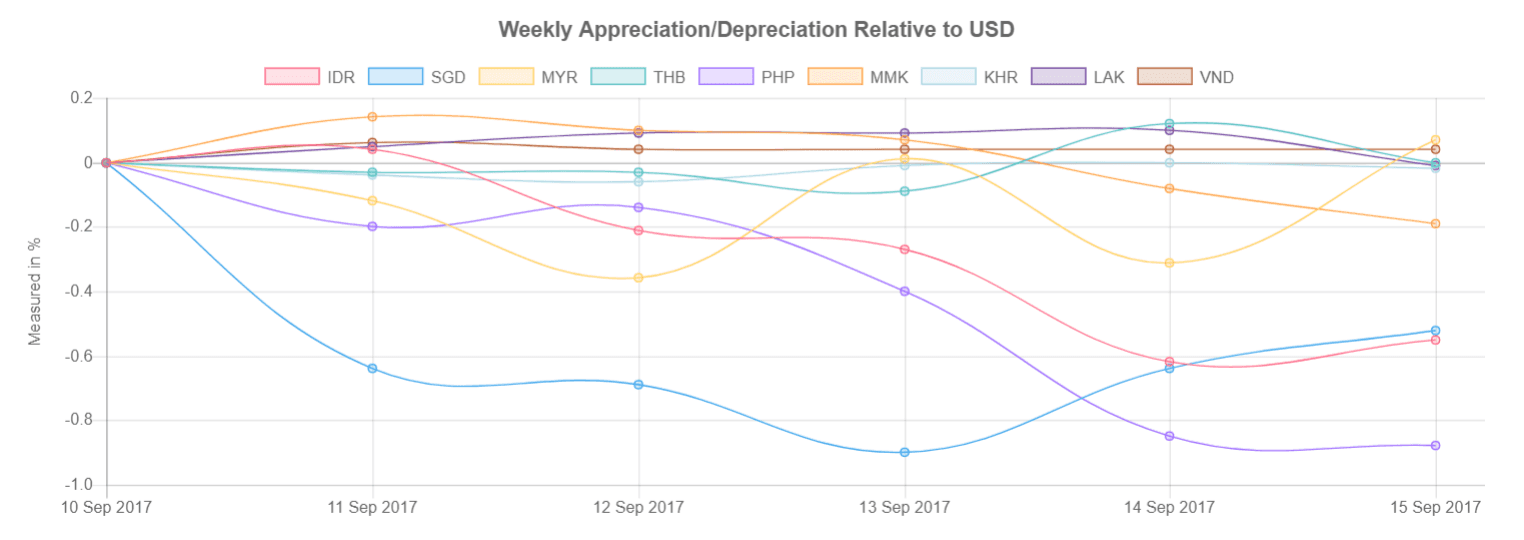Each week, we provide an overview of the percent returns of the primary indices in Southeast Asia and their currency appreciation or depreciation relative to the US Dollar. We provide this information below. We also capture this information, as well as the trailing four and year-to-date movements, and plot the data in charts, which you can find on the “index charts” and “currency charts” pages.
Indices
During the week of 18 September, six of the ten indices in Southeast Asia advanced, with the Hanoi Stock Exchange (HNX) index rising the most, increasing 1.94%. Domestic investors drove the weekly gain as foreign investors were net sellers of the index by approximately VND 1 million, or USD 44,000, based on a review of the HNX’s daily statistics.
The Philippine Stock Exchange index had the second greatest gain during the week, rising 1.23%. Positive macroeconomic news probably boosted investor sentiment and contributed to the week’s rally. For instance, on Wednesday, the country’s central bank, Bangko Sentral ng Pilipinas (BSP), reported that the country’s current account deficit narrowed to a USD 7 million deficit, from USD 678 million the month prior, according to The Manila Times. On Monday, the BSP reported that foreign debt fell USD 5.2 billion from the previous year, to USD 72.5 billion, and the country’s external debt ratio improved to 19.5% from 21.7%, according to The Manila Times.
Weekly gains
- Hanoi Stock Exchange Index (HNX), 1.94%
- Philippine Stock Exchange index (PSEi), 1.23%
- Jakarta Stock Exchange index (JSX), 0.67%
- Cambodia Securities Exchange index (CSX), 0.37%
- Singapore’s Straits Times Index (STI), 0.33%
- Ho Chi Minh Stock Exchange Index (VNI), 0.16%
Weekly declines
- Stock Exchange of Thailand index (SET), -0.09%
- Lao Securities Exchange index (LSX), -0.63%
- Myanmar’s Myanpix index (YSX), -0.67%
- Kuala Lumpur Composite Index (KLCI), -0.86%
Currencies
Two of the nine primary Southeast Asian currencies advanced relative to the US Dollar the week of 18 September, with the Philippine Peso increasing 1.18%. The BSP’s announcement that the country’s current account narrowed in August, according to The Manila Times, probably helped drive the currency’s gain, which has been the region’s weakest year-to-date.
The Thai Baht, which has been the region’s strongest currency year-to-date, was flat through Thursday but gained 0.08% on Friday, giving it the second strongest return this week. On Thursday, the Commerce Ministry announced that exports in August increased 13.2% year-on-year, which was the fastest growth in 55 months, according to The Bangkok Post.
Weekly appreciations
- Philippine Peso (PHP), 1.18%
- Thai Baht (THB), 0.08%
- Lao Kip (LAK), 0.00%
- Vietnamese Dong (VND), 0.00%
Weekly depreciation
- Singapore Dollar (SGD), -0.04%
- Malaysian Ringgit (MYR), -0.20%
- Cambodian Riel (KHR), -0.25%
- Myanmar Kyat (MMK), -0.40%
- Indonesian Rupiah (IDR), -0.54%



